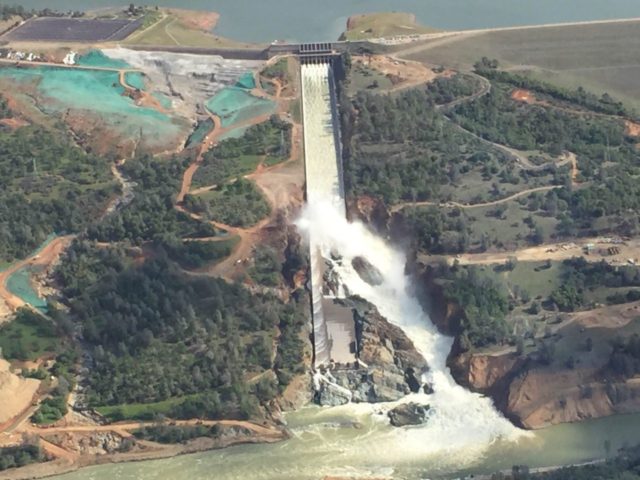The California Department of Water Resources has finally released two engineering reports that reveal Oroville Dam’s spillways cannot be fully repaired before the next rainy season.
The State of California had argued that national security concerns were the reason safety expert reports regarding the damage to Oroville Dam spillways, and the probability of full repairs being completed before the November 1 beginning of the next “water year,” were being withheld from the public.
But with the political furore from concerned downstream communities rising fast, the State of California just published the No. 2 Board of Consultants (BOC) Memorandum, dated March 17, and No. 3 BOC Memorandum, dated March 31. Certain sections were black-line redacted to supposedly protect against any national security risk releases.
The good news is that drill coring has revealed that the thickness of the fractured cement main spillway slab is 2.0 to 3.2 feet. That is much thicker than initially suggested in reports by the Sacramento Bee and others, which indicated that the “concrete chute is only a foot thick, and less so in some places.”
But the extremely bad news is that historical construction photographs revealed the “concrete slab was placed on a variety of materials that ranged from clean, hard, bedrock to highly weathered rock that appeared soil-like.” That explains why the spillway broke-up as soon as water discharge rates were increased in early 2017.
The BOC reports are consistent with Breitbart News’ April 11 report that California’s preeminent expert regarding tectonic plate earthquakes and Alpine strata geology, Eldridge M. Moores, believed the spillways failed and almost took down the Oroville Dam itself.
The March 31 BOC report states that the analysis is still incomplete, because there would need to be more coring holes drilled to ”15 to 30 feet to determine the depth to fresh rock and, hence, the required depth of the new anchor embedment.”
Given that the University of California Davis measured the main spillway as 80 feet wide and 1,700 feet long, the BOC report means that between 2 to 4 million cubic feet of incompetent “soil-like” rock needs to be dug out, replaced with 2 to 4 million cubic feet of fresh rock, and then covered with a quarter to a half million cubic feet of new cement.
The BOC “Interim Repairs” goal for the main spillway is to achieve a peak water outflow capacity of 270,000 cubic feet of water per second. But according to Breitbart sources, it would be impossible, even with a shut-down and completely dry spillway, to complete such an extensive reconstruction project by November 1.
The task will be spectacularly more challenging, given that the latest Oroville Lake inflow of 23,421 cubic feet of water per second has forced dam engineers to continue discharging 35,037 cubic feet of water per second down the semi-destroyed main spillway. Coupled with a record snowpack expected to take months to run off completely, it is doubtful that the main spillway can be closed on an interim basis before some time in late July.
The BOC commented that water discharge could normally be rerouted to the emergency spillway, which had a rated capacity of 250,000 cubic feet per second. But the BOC experts determined that the closed emergency spillway was also built with incompetent rock due to “weathering.” The BOC goal for “Interim Repairs” to the emergency spillway, is only to create a 30,000-cubic feet per second capacity before next year’s rainy season.

COMMENTS
Please let us know if you're having issues with commenting.